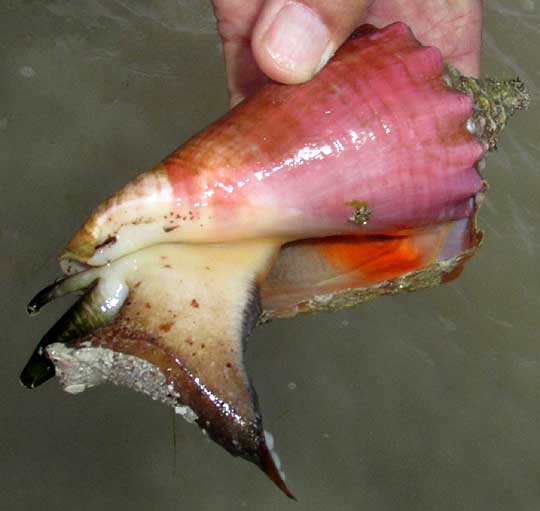Excerpts from Jim Conrad's
Naturalist Newsletter
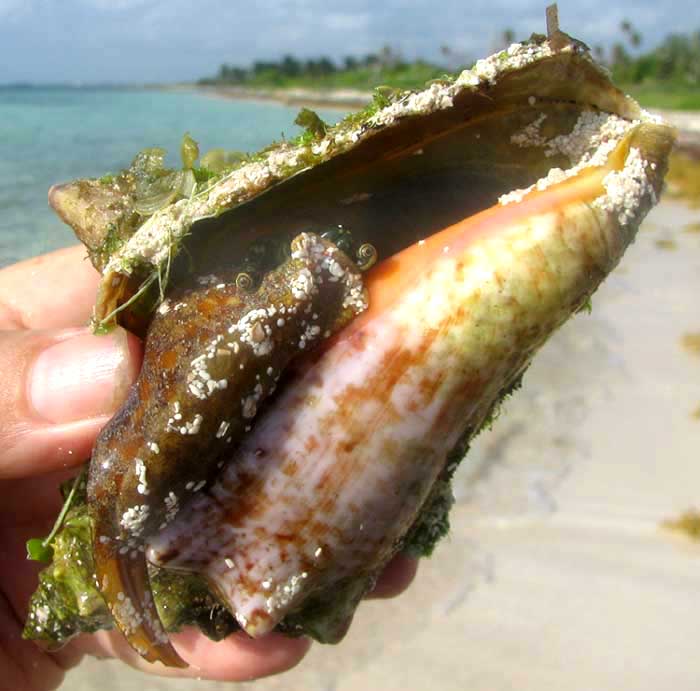
from the August 21, 2011 Newsletter issued from Mayan Beach Garden Inn 20 kms north of Mahahual; Caribbean coastal beach and mangroves, ~N18.89°, ~W87.64°, Quintana Roo state, MÉXICO
QUEEN CONCH COME-OUT
Up at the rocky point you see lots of empty, bleached-white Queen Conch shells (conch pronounced KONK), ALIGER GIGAS, not least because the locals eat them with relish, year round. When I saw a smallish conch shell moving across the sand close to shore in less than a foot of water, it was usual.
It was also strange that through the choppy water I seemed to be seeing three or four black, slender, straight appendages below the shell. Was this an aquatic hermit crab carrying a borrowed shell around? When I retrieved the shell from the water, at first the creature cowered so far inside that only a hard, claw-like structure and some soft, brown flesh showed. But then the claw extended farther, and a pair of stalked eyeballs emerged staring at me, as shown at the top of this page.
For several seconds I stood there trying to reconcile the thought that we had a hermit crab with one claw extended, but the knowledge that crabs are arthropods with jointed legs and brittle exoskeletons. Yet the leg attached to the claw right in front of me looked like a mushy mass of exposed flesh. The flesh looked like that of a snail or other mollusk, but do mollusks ever have claws? Maybe the black, strawlike things I'd seen had been antennae and stalked eyes, not legs.
The critter and I gawked at one another mutually clueless as to what we were seeing when suddenly for half a second it was like that scene in the 1979 movie Alien when a slimy space monster bursts from the chest of an astronaut. Something like an impossibly long -- for such a small shell -- fleshy arm hooked at the end and bearing stalked eyes where the elbow should be shot from the shell right at my face, then collapsed from its own weight and began hacking at my arm with its hook. You can see the eyed, hooked arm below:

After a few seconds the creature seemed to realize how exposed he was and how useless it was hacking at my arm, so he withdrew more into the shell, his roving stalked eyes looking around, as shown below:

The short version of the rest of the story is that soon a bit of Googling convinced me that we were simply being granted an unusual view of the Queen Conch living organism. Marcia says she's never seen a conch behave like this, and on the Internet among hundreds of pictures of living Queen Conches, none that I find show the body so extended from the shell, ending in a hook.
That hook is actually an operculum, the stiff covering many snails and other mollusks bear at the bottom of their feet. When the mollusk withdraws into its shell, the fingernail-like operculum is the "door" closed against the outside world. I find no reference to Queen Conches using their operculums as hooks in self defense, which is just as well, since it looks more dangerous than it really is.
In that last picture, of the face, it's easy to recognize the stalked eyes, but what is that fleshy, fingerlike growth arising immediately below and between the eye stalks? That's the proboscis, or snout. Notice how the proboscis bears a slit at its end. That's the mouth. The large, fleshy area below the eyes and proboscis constitutes the foot, and we've seen that that foot can be extended much farther than in the last picture.
It seems that I'm learning about these things just like a kid does, poking about on my own and sometimes having the bejeezers scared out of me, and that's exactly how I like it.
from the August 21, 2011 Newsletter issued from Mayan Beach Garden Inn 20 kms north of Mahahual; Caribbean coastal beach and mangroves, ~N18.89°, ~W87.64°, Quintana Roo state, MÉXICO
POACHING CONCH
Despite the year-round poaching of conch by local folks along the beach, laws are in place to protect the Queen Conch. Here it is illegal to capture, buy, transport, sell or even eat conch from May 1 to October 31. Queen Conches are mating now, and that's why this week I got to see one so close to shore.
In the interior we've seen heavy, year-round poaching of deer and other wildlife, despite adequate laws being on the books. Here maybe the conch laws are taken a little more seriously and I think I know why: To the military who constantly patrol these waters, conch hunters at a distance look just like drug runners.
Still, since I've been here I've heard of three local conch-busts by the military. Last week a local man gathering conch along the beach near his house in Sian Ka'an Biosphere Reserve was arrested. The other two encounters were late at night when a military patrol boat stopped poachers offshore in boats. Guns were fired in both instances, and one poacher -- who had been caught and released during the previous encounter -- was shot in the leg as he tried to escape.
During the last encounter, the poachers dumped about 500 pounds (225kg) of conch overboard to get rid of evidence.
from the January 5, 2009 Newsletter issued from Mayan Beach Garden Inn 20 kms north of Mahahual; Caribbean coastal beach and mangroves, ~N18.89°, ~W87.64°, Quintana Roo state, MÉXICO
QUEEN CONCH SHELLS
On eBay Queen Conch shells are going for about US $20 apiece, but around here they're so numerous that visitors pick up only the prettiest. You can see one use a neighbor has for his Queen Conches below:
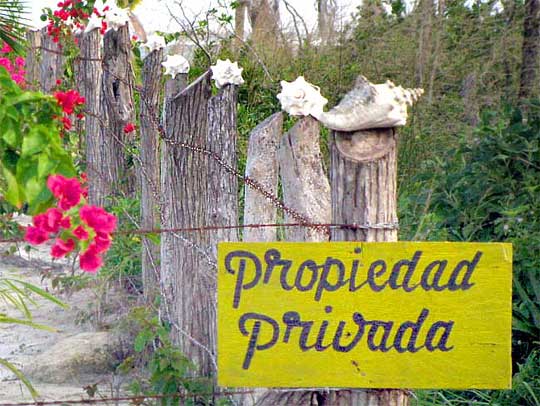
He's placed dozens and dozens atop fence posts around his property. Other people use them to define driveways and walkways around their homes. By the way, "Propiedad Privada" means "Private Property." A shell of Queen Conch, ALIGER GIGAS, appears in my hand below:
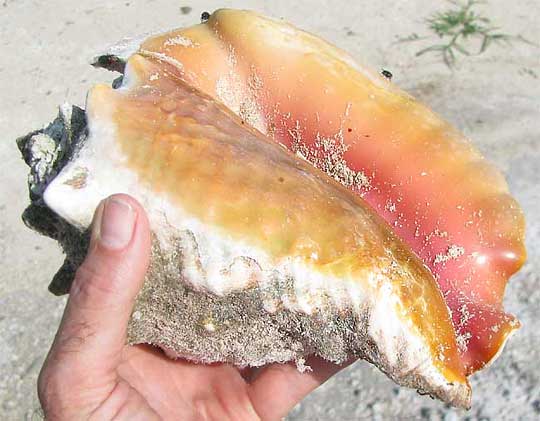
Is the word "conch" pronounced the way it looks, or like "conk"? I read that originally the word was pronounced "conk" but so many people over the years began mispronouncing it based on the way it looked that now the mispronunciation is usually accepted in dictionaries.
Queen Conches are big snails, and they're having a problem, less because people collect their shells than that people eat them. A NOAA news release in 2003 reported that Queen Conch populations in Honduras, Haiti and the Dominican Republic are exploited at rates that may be unsustainable. Also it says that the US imports approximately 80% of world trade in them, usually more than 1,000 metric tons of Queen Conch meat a year. You can read the whole release here.
Marcia confirms that Queen Conch populations just offshore here are suffering. She says that they come into shallow water when the water is warmest, in July and August, to mate. In the past they were common but now they're so rare that they have a hard time finding one another. Despite having read that you're not supposed to handle them, Marcia is convinced that she sees a bigger problem than being handled, so when they start coming into shallow water she collects them and leaves them in small groups so they can find one another and mate. Local fishermen gather them to eat, making no effort to leave breeding stock. They stab knives into them, pry out the flesh, and leave the shells dumped on the beach -- untold numbers of them. Finding enough bleaching shells to adorn your fence posts is no big problem.
Of course such unlimited hunting is illegal, but so are a lot of things that get done here very much in the open.
from the March 22, 2015 Newsletter issued from Río Lagartos, on the Yucatan Peninsula's northern coast (~N21.60°, ~W88.16°), Yucatán state, MÉXICO
SMALL QUEEN CONCHS
At Río Lagartos we also have Queen Conchs, but so far every one I've seen has been young and small -- too small for the local folks to catch and eat. These are beautiful creatures and young ones can have shells that look a little different from big ones, so I'm providing photos of them just for the record. One with a pale, yellow-orange shell is shown below:
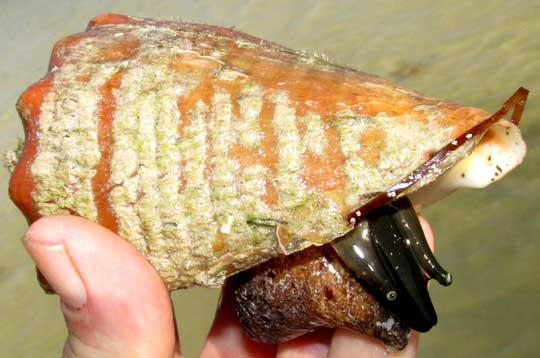
When you turn the shell over, however, the familiar brighter hues appear, shown below:
